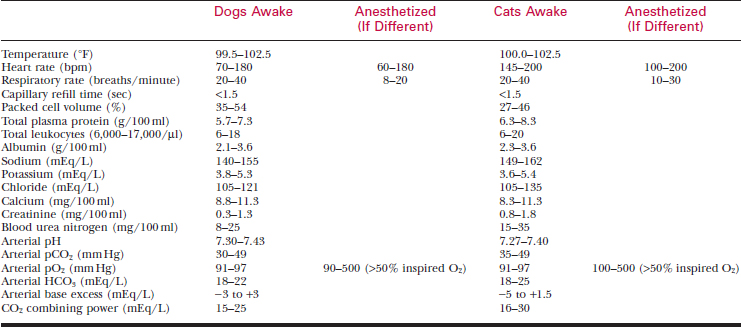Chapter 2 Practical Methods of Anesthesia
Anesthesia is an integral part of the practice of companion animal medicine. In addition to surgical applications, some form of anesthesia may be required for a wide variety of procedures, such as radiography, endoscopy, cerebrospinal fluid collection, and bone marrow aspiration.
GENERAL PRINCIPLES
Preoperative Assessment (Table 2-1)
Table 2-1 PREANESTHETIC CHECKLIST
History and Physical Examination
Pulse rate, rhythm, and strength
Hydration, mucous membrane color, and capillary refill time
Laboratory Data
Blood urea nitrogen, creatinine, or serum dipstick analysis (Azostick) if less than 7 years
Endotracheal Intubation
A patent airway is essential to any anesthetic protocol.
Table 2-3 APPROXIMATE ENDOTRACHEAL TUBE SIZES
| Weight (kg) | Cuffed Tube Diameter (mm) | |
|---|---|---|
| Dogs | 3–7 | 3.0–5.0 |
| 7–15 | 5.0–7.5 | |
| 15–30 | 7.5–9.5 | |
| >30 | 9.5–12.0 | |
| Cats | 2.5–4.0 | |
PRODUCING A TRACTABLE ANIMAL
The doses of drugs alone and in combination are listed in Table 2-4 (dogs) and Table 2-5 (cats).
Table 2-4 ANESTHETIC DRUGS AND DOSES IN DOGS
| Drug | Intravenous Dose (mg/kg) | Intramuscular or Subcutaneous Dose (mg/kg) |
|---|---|---|
| Anticholinergic | ||
| Atropine | 0.02–0.04 | 0.02–0.04 |
| Glycopyrrolate | 0.005–0.010 | 0.005–0.010 |
| Tranquilizer/Sedative | ||
| Acepromazine | 0.05–0.20 | 0.1–0.3 |
| Xylazine | 0.3–0.8 | 0.5–1.5 |
| Medetomidine | 0.007–0.020 | 0.01–0.04 |
| Diazepam | 0.10–0.25 | 0.10–0.25 |
| Midazolam | 0.05–0.20 | 0.1–0.2 |
| Analgesic | ||
| Morphine | NR* | 0.2–0.5 |
| Oxymorphone | 0.05–0.10 | 0.1–0.3 |
| Fentanyl | 0.002–0.005 | 0.004–0.008 |
| Meperidine | 0.4–2.0 | 1.0–4.0 |
| Butorphanol | 0.1–0.2 | 0.1–0.4 |
| Nalbuphine | 0.5–2.0 | 0.5–2.0 |
| Buprenorphine | 0.005 | 0.005 |
| Hydromorphone | 0.05–0.2 | 0.1–0.4 |
| Anesthetic | ||
| Tiletamine/zolazepam (Telazol) | 0.5–4.0 | 4–10 |
| Thiopental | 6–10 | NR |
| Etomidate | 1–4 | NR |
| Propofol | 2–6 | NR |
| Combination | ||
| Acepromazine/oxymorphone | 0.05–0.10/0.01–0.02 | 0.1–0.2/0.1–0.2 |
| Acepromazine/butorphanol | 0.05–0.10/0.1–0.2 | 0.1–0.2/0.1–0.2 |
| Ketamine/acepromazine | 2–5/0.05–0.10 | 5–10/0.1–0.2 |
| Ketamine/xylazine | 1–5/0.1–0.8 | 5–10/0.3–1.5 |
| Ketamine/diazepam (50:50) | 1 ml/10 kg | NR |
Table 2-5 ANESTHETIC DRUGS AND DOSES IN CATS
| Drug | Intravenous Dose (mg/kg) | Intramuscular or Subcutaneous Dose (mg/kg) |
|---|---|---|
| Anticholinergic | ||
| Atropine | 0.02–0.04 | 0.02–0.04 |
| Glycopyrrolate | 0.005–0.010 | 0.005–0.010 |
| Tranquilizer/Sedative | ||
| Acepromazine | 0.05–0.20 | 0.1–0.3 |
| Xylazine | 0.4–1.0 | 0.8–1.8 |
| Medetomidine | 0.01–0.03 | 0.03–0.08 |
| Diazepam | 0.10–0.25 | 0.10–0.25 |
| Midazolam | 0.05–0.20 | 0.1–0.2 |
| Analgesic* | ||
| Oxymorphone | 0.01–0.04 | 0.05–0.10 |
| Butorphanol | 0.05–0.20 | 0.1–0.3 |
| Nalbuphine | 0.5–1.5 | 0.5–1.5 |
| Buprenorphine | 0.005 | 0.005 |
| Hydromorphone | 0.05–0.1 | 0.1–0.3 |
| Anesthetics | ||
| Ketamine | 4–10 | 10–20 |
| Tiletamine/zolazepam (Telazol) | 0.5–4.0 | 4–12 |
| Thiopental | 6–10 | NR† |
| Etomidate | 1.0–4.0 | NR |
| Propofol | 2–6 | NR |
| Combination | ||
| Acepromazine/oxymorphone | 0.05–0.07/0.01–0.04 | 0.1–0.2/0.05–0.20 |
| Acepromazine/butorphanol | 0.05–0.07/0.07–0.15 | 0.1–0.2/0.1–0.2 |
| Ketamine/acepromazine | 4–8/0.05–0.10 | 7–15/0.1–0.2 |
| Ketamine/xylazine | 4–8/0.1–0.8 | 7–15/0.3–1.5 |
| Ketamine/diazepam (50:50) | 1 ml/10 kg | NR |
* Higher doses can be associated with nervousness and excitement.
Tranquilizers
Acepromazine
Xylazine
Medetomidine
Diazepam and Midazolam
Stay updated, free articles. Join our Telegram channel

Full access? Get Clinical Tree



